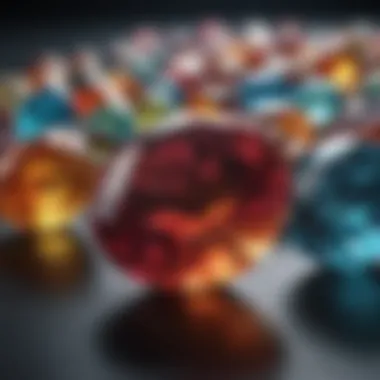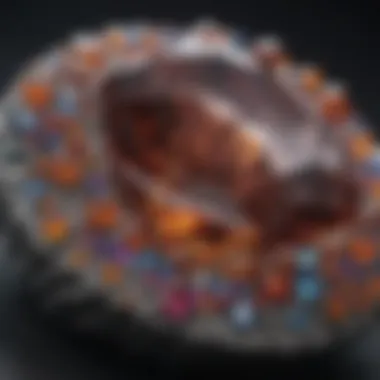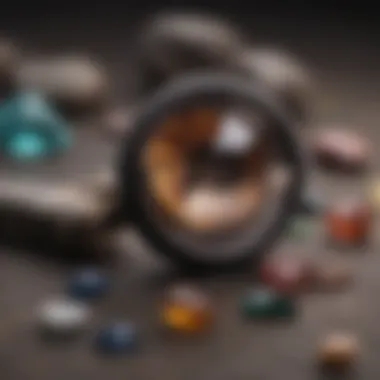How to Identify Stones in Jewelry: A Complete Guide


Intro
Topic Overview
Definition of gemstones
Gemstones are naturally occurring minerals or rocks that are cut and polished for use in jewelry. They can be categorized into precious and semi-precious stones, distinguishing them based on rarity, quality, and market value. Each stone has its distinct characteristics, making recognition essential for collectors and casual wearers alike.
Brief history and significance
Historically, gemstones have held great significance across cultures. Ancient civilizations believed that specific stones could bring protection, luck, or health benefits. For instance, Egyptians valued turquoise as a symbol of wealth and protection, while amethyst was thought to ward off intoxication. Today, the beauty and craftsmanship of gemstones continue to captivate and form a cornerstone in the world of jewelry, symbolizing status and personal expression.
Identification and Classification
How to categorize items
When identifying gemstones, one primarily looks at factors such as:
- Color: The hue can significantly influence value and identification, though it's crucial to note that some stones come in various colors.
- Clarity: The absence of inclusions or blemishes can define a stone’s quality.
- Carat weight: Larger stones are generally rarer and more valuable.
- Cut: The precision of the cut affects both the stone’s aesthetic and its brilliance.
Using these categories, you can start to classify stones more effectively. For practical purposes, a well-organized reference chart can help track characteristics, comparing stones side-by-side for a clearer understanding.
Tips for identifying key features
To identify stones accurately, keep the following methods in mind:
- Inspect under natural light: Gemstones often look different under artificial lighting. Natural light provides the most accurate view of their true color and brilliance.
- Use a loupe or magnifying glass: This can reveal inclusions and scratches that aren’t visible to the naked eye, helping to clarify its identity.
- Conduct a scratch test: While not always advisable for valuable items, testing against minerals of known hardness (like quartz) can help determine a stone's hardness level on the Mohs scale.
- Check for thermal conductivity: Some stones, like diamonds, will disperse heat quickly. Thermal testers specifically designed for gem identification can assist in this process.
Important Note: Always be cautious with tests that may damage the stone. It's best to test on a specimen that's not a prized possession.
As you navigate this multifaceted world of gemstones, remember that patience and practice are key. Developing an eye for detail and familiarity with different stones will ultimately enrich your understanding and appreciation of these natural wonders.
Foreword to Gemstone Identification
Navigating the world of gemstones in jewelry can feel like wandering through a vast labyrinth without a map. Gemstone identification is not just about distinguishing between colors and shapes; it’s a skill that encapsulates art, science, and history. Recognizing the exact stone you’re dealing with can open up a treasure trove of knowledge about its value, durability, and even its origin.
The Importance of Accurate Identification
When it comes to jewelry, accuracy is king. Each stone carries its own unique energy and beauty, which can affect its market value significantly. Imagine purchasing a stunning synthetic amethyst at the price of a natural one; a costly mistake, indeed! Moreover, identifying gemstones correctly is crucial for preserving their integrity and ensuring they receive proper care. A diamond, for instance, demands a different cleaning procedure than a turquoise.
Accurate identification also empowers collectors and enthusiasts to understand the broader cultural and historical context of their pieces. For example, certain gemstones have been prized in specific cultures; jade in China symbolizes purity, while lapis lazuli was favored by the ancient Egyptians for its celestial symbolism.
An Overview of Gemstones in Jewelry
The vast array of gemstones used in jewelry can dazzle even the sharpest of minds. Gemstones generally fall into two categories: precious and semi-precious. Precious stones, like diamonds, rubies, sapphires, and emeralds, have long been regarded as the crème de la crème of the jewelry world due to their rarity and brilliance. On the other hand, semi-precious stones like garnets, amethysts, and peridots, while plentiful, also hold significant beauty and allure.
A few key considerations for gemstone enthusiasts are:
- Variety: With over 200 recognized varieties, gemstones come in many shapes, colors, and sizes.
- Value: A stone’s market value can fluctuate based on factors like rarity, demand, and even fashion trends.
- Care: Different stones have distinct physical and chemical properties, dictating appropriate care methods.
Understanding these elements not only enhances your appreciation of the stones but also equips you with the knowledge to make informed decisions while buying or selling jewelry. Gemstone identification is laying the foundation for a deeper relationship with these natural wonders.
Understanding Gemstone Properties


Understanding the properties of gemstones is crucial for anyone looking to identify stones in jewelry. Each gemstone comes with its own set of characteristics that can aid or hinder identification, so diving into these properties offers a solid foundation. The more familiar you are with these attributes, the more equipped you become to distinguish one stone from another. This understanding not only enhances your ability to identify stones accurately but also deepens your appreciation for the beauty and complexity of these natural elements.
Physical Properties of Gemstones
Physical properties serve as the first line of identification for gemstones. Let’s break this down into three key properties: hardness, luster, and color.
Hardness
Hardness is defined by a gemstone's resistance to scratching. The Mohs scale, which ranges from 1 (talc) to 10 (diamond), evaluates this quality. It proves significant because it informs potential buyers and collectors of the durability and suitability of a stone for various types of jewelry. For instance, a diamond’s exceptional hardness makes it ideal for engagement rings, enduring daily wear without significant wear and tear.
Unique Feature: The hardness of a gemstone can vary depending on its crystalline structure, making some stones suitable for more delicate settings than others.
Advantages/Disadvantages: While harder stones are often more valuable, softer stones can be equally beautiful but require more careful handling.
Luster
Luster refers to how light interacts with the surface of a gemstone. It can range from a dull finish to a shiny appearance, categorized into types like vitreous, pearly, or metallic. Luster plays a vital role in a gemstone's appeal. For instance, the glassy luster of a garnet or the silky luster of a fresh-water pearl both enhance the visual treat of these stones, making them more sought after.
Unique Feature: Different minerals can exhibit varying types of luster, which can assist in narrowing down identification.
Advantages/Disadvantages: While shiny stones often attract attention, duller stones may offer unique qualities that could appeal more to some collectors.
Color
Color is perhaps the most immediately noticeable property of gemstones. It stems from their chemical composition and crystalline structure. The vibrant hues of gemstones like rubies and sapphires are among the most captivating. But remember, color can also be misleading; some stones can appear similar at a glance, making it imperative to consider variations in shade, saturation, and even zoning.
Unique Feature: Color grading in gemstones often considers transparency and saturation, which can vary widely among individual stones of the same type.
Advantages/Disadvantages: Brightly colored stones tend to be more valuable, but the subtler shades can sometimes resonate more deeply with collectors seeking uniqueness.
Optical Properties and Their Importance
Optical properties help define how gemstones interact with light beyond just luster. This includes refraction, birefringence, and dispersion, all of which contribute to the overall aesthetic appeal and uniqueness of a gemstone.
Refraction
Refraction refers to how light bends as it passes through a gemstone. Each stone has a specific refractive index, which can help distinguish among various types. For example, sapphires and rubies (made of corundum) exhibit a specific refractive index that is different from that of quartz or topaz. This property helps jewelers determine authenticity and different types of gems effectively.
Unique Feature: The ability to measure light bending in stones allows for quick differentiation between natural and synthetic origins.
Advantages/Disadvantages: Although this is a valuable identification method, it often requires specialized tools like a refractometer, which can be an investment.
Birefringence
Birefringence involves the phenomenon where a gemstone displays two different refractive indices depending on its crystallography. This characteristic is most prominent in certain gems like calcite and tourmaline. Identifying this feature can be key, particularly when distinguishing between similar-looking stones.
Unique Feature: Birefringence gives some gems their unique visual characteristics, including doubled images.
Advantages/Disadvantages: While fascinating, measuring birefringence often requires experience and specific equipment.
Dispersion
Dispersion is the way light is spread into its constituent colors when passing through a stone. This is what lends certain gemstones their 'fire', as seen in diamonds. A high dispersion rating often signals higher value and desirability, making this property crucial among collectors.
Unique Feature: The interplay of light and color created by dispersion is frequently sought after in fine jewelry pieces.
Advantages/Disadvantages: High dispersion can make a gemstone more attractive, but it also leads to a range of expectations regarding quality based on how prominently this feature is displayed.
Chemical Composition: What You Need to Know
The chemical composition of gemstones plays a critical role in understanding their distinctive features. Each mineral has a unique formula that not only defines its physical and optical properties but also informs its rarity and value in the market. Recognizing the elements that make up a gem—like the traces of chromium in emeralds or iron in sapphires—opens a deeper insight into both the stone's origin and its worth. For collectors, knowledge of chemical composition is essential for ensuring authenticity and value over time.
Common Types of Gemstones in Jewelry
Identifying gemstones in jewelry is more than a mere curiosity; it’s about understanding the very essence of these natural wonders. The category of common gemstones helps enthusiasts delineate between various kinds, unraveling the stories of each stone. Knowing whether a stone is classified as precious or semi-precious can greatly influence not just the aesthetic appeal, but also the value and meaning behind them. A nuanced appreciation brings forth a deeper connection to the jewelry, making the experience more fulfilling.


Precious Stones vs. Semi-Precious Stones
When it comes to gemstones, the terms "precious" and "semi-precious" offer a foundational understanding of their rarity and value. Precious stones, which include diamonds, rubies, emeralds, and sapphires, are typically rarer and more sought-after in the jewelry market. These stones are not only valued for their scarcity but also for their exceptional qualities, making them go-to choices in high-end jewelry.
On the other hand, semi-precious stones, such as amethyst, garnet, and turquoise, do not hold the same level of scarcity but often boast unique colors and properties. While they may not carry the same hefty price tag, semi-precious stones can captivate with their beauty and individuality.
Comparing these two categories offers insights into market trends and personal preferences. While some collectors gravitate toward the allure of precious stones, others may find themselves enchanted by the variety and affordability of semi-precious ones.
Popular Gemstones and Their Characteristics
Diamond
Diamonds are often hailed as the king of gemstones, primarily due to their unmatched hardness and timeless beauty. Their light-refracting abilities make them sparkle like no other. The brilliance of a diamond is an essential characteristic; it’s what captures the eye and the heart. Not only does diamond symbolize love and commitment, making it a popular choice for engagement rings, it also holds significant investment value. However, the market can be volatile, and prices may swing drastically based on market demand and availability.
Ruby
The rich, red hue of a ruby resonates with warmth and passion. Known as the "king of gemstones,” rubies are believed to possess protective powers and are associated with vitality and energy. The deep color intensity is a primary characteristic, with more vibrant stones fetching a higher market value. However, fine rubies are becoming increasingly rare, making them not only treasured heirlooms but also clever investments that can appreciate over time.
Sapphire
Sapphires are most commonly associated with a stunning blue, but they can appear in a spectrum of colors except for red. The diversity in hues gives buyers choices tailored to their tastes. Known for their durability, sapphires are an excellent choice for daily wear. Their unique feature is the color variety which can enhance personalization in jewelry pieces. They stand as a practical yet beautiful option in any gem collector's cache.
Emerald
Emeralds embody the lushness of the forest and evoke a sense of serenity. They are known for their vibrant green color but often come with inclusions that are not only common but can sometimes enhance their character. This is an interesting aspect as many gemstone collectors might shy away from inclusions, yet in the case of emeralds, they are accepted as part of that stone’s identity. While emeralds command high prices, particularly those without noticeable inclusions, their unique beauty makes them unforgettable in the jewelry industry.
Amethyst
Amethyst, a close relative of quartz, is revered for its deep purple shades and affordability. Belonging to the semi-precious category, certain high-quality amethysts can fetch impressive prices, especially when they display an intense hue. Amethyst’s unique feature is its versatility, appearing in various jewelry forms—from rings to necklaces. Its rich history has made it a favored stone, especially in spiritual practices, symbolizing calm and clarity.
Unique and Uncommon Gemstones
Opal
Opals are distinct for their play-of-color phenomenon, which means they reflect light in a way that reveals a range of colors. This characteristic is uniquely captivating and can make every opal a one-of-a-kind treasure. The charm of opals can make them a beneficial selection for those looking to enhance their collection with something that stands apart. However, their structure makes them delicate, requiring careful handling.
Tanzanite
Tanzanite, discovered in the late 1960s, offers a striking blue-violet hue that has taken the market by storm. Its relative newness adds an air of novelty and exclusivity, appealing to collectors and jewelry enthusiasts alike. The unique feature of tanzanite is its pleochroism, meaning it shows different colors when viewed from different angles. This can add an exciting dimension to pieces, but potential buyers should be wary of its rarity and ensure authenticity.
Alexandrite
Alexandrite is renowned for its remarkable color-changing ability; it appears green in daylight but shifts to a reddish-purple indoors. This aspect elevates its allure and mystique. The rare nature of high-quality alexandrite makes it an enticing investment for gemstone collectors. However, potential buyers must ensure they are dealing with a genuine stone due to the prevalence of synthetics on the market.
Identification Techniques
Identifying gemstones is a nuanced endeavor, akin to peeling an onion—you must carefully uncover layers to arrive at the core. Understanding identification techniques is crucial because they allow enthusiasts to discern an authentic gem from a mere imitation. The practice of recognizing differences not only enhances appreciation but also avoids the pitfalls of acquiring overpriced or misrepresented stones. Effective identification methods can boost one’s credibility in both personal and commercial endeavors.
Visual Inspection and Observation
The first step toward identifying a gemstone usually goes through the eyes. Visual inspection is the most accessible technique, as it doesn't require any specialized tools. However, seeing is not always believing. Take into account the gemstone's color, transparency, and clarity.
- Color: Each gemstone has its own specific hues; for example, sapphires are typically blue, albeit they can be found in various other colors, known as "fancy sapphires."
- Transparency: Observe if the gemstone allows light to pass through. Crystals like diamonds are transparent, while others may appear cloudy or opaque in nature.
- Clarity: Check for inclusions, which are blemishes or internal characteristics. A stone with fewer inclusions tends to be more valuable.


Being mindful of these factors helps build a baseline understanding of the stone. Yet, this technique isn't foolproof—similar-looking gems can easily mislead the untrained eye.
Using Gemstone Test Kits
For those who want to dig a little deeper without breaking the bank, gemstone test kits are a handy option. These kits often include tools designed to assess the physical and optical properties of gemstones. Having such a kit opens a gateway to a more refined analysis.
- Tools typically include:
- Refractometers: Measure how light bends in a stone, which is vital for identifying specific gemstones.
- Loupe or Magnifying Glass: Make small imperfections and inclusions more visible.
- Hardness Testing Kits: Determine how resistant a gemstone is to scratching, employing the Mohs scale for reference.
Utilizing these tools can fortify your confidence during identification. Just be sure to follow instructions closely; a simple miscalculation can lead you astray.
Laboratory Testing: When to Seek Professional Help
There are moments when even the best-equipped amateur must concede to the experts. If you encounter a stone that refuses to reveal its true identity through visual inspection or test kits, consider reaching out to a laboratory for testing.
Professional labs can provide services such as:
- Chemical analysis: Identifying the gemstone's chemical composition to confirm authenticity.
- Advanced optical testing: Using sophisticated equipment to analyze light performance within the gem.
- Certification services: Offering credible verification and certification for gemstones, critical for high-value purchases.
"Sometimes, valuing a stone goes beyond what the eye can see. Relying on professionals may save heartache in the long run."
In summary, mastering identification techniques not only enriches an enthusiast's knowledge but also safeguards investments. By blending visual inspection with further testing, anyone can become better equipped to unveil the true identity of gemstones.
Caring for Natural Stones in Jewelry
Caring for natural stones in jewelry is essential for maintaining their beauty and integrity. Each gemstone comes with its own set of characteristics that require tailored approaches to ensure longevity and stunning appearances. Understanding how to clean, maintain, and protect these treasures enhances not only their aesthetic appeal but also their value, making it a worthy investment for any collector or enthusiast.
Cleaning and Maintenance Practices
Keeping your jewelry clean is more than just about looking good; it’s about preserving the stone’s quality. Different gemstones require varied cleaning methods to avoid damage.
- Ultrasonic Cleaners: Great for tough grime on harder stones like diamonds or sapphires but should be avoided for those with inclusions.
- Soaps and Brushes: A mild solution of warm water with gentle soap and a soft brush works wonders for most stones. Just be careful with porous gems like turquoise, which can absorb moisture.
- Professional Cleaning: For valuable or delicate pieces, professional cleaning services can provide a thorough job without the risk of damage. Always inform the jeweler about the specific stone to ensure they use the proper techniques.
Maintaining stones goes beyond cleaning; regular checks are essential. Inspect settings, watch for looseness in prongs, and appreciate any unexpected signs of wear.
Protecting Stones from Damage
Natural stones are resilient, but they’re not invincible. Understanding how to shield them can save you a hefty repair bill down the line.
- Storage: Always store gemstones separately to avoid scratching. Use soft cloth pouches or specialized jewelry boxes.
- Avoid Harsh Chemicals: Substances like bleach or ammonia can tarnish or degrade stones. Always remove jewelry before using cleaning products around the house.
- Limit Exposure to Air: Some stones like opals can lose water content over time, leading to dullness. Keep them in airtight containers when not in use is a smart move.
"Prevention is better than cure"—This idiom couldn't ring truer when it comes to caring for your gemstones.
The End
Identifying gemstones in jewelry transcends mere aesthetics; it is an endeavor steeped in understanding, history, and craftsmanship. This article has illuminated a path for both novice and seasoned gem enthusiasts, bridging the gap between superficial appreciation and profound knowledge. By recognizing the characteristics that make each stone unique, collectors can not only comprehend the value of their pieces but also appreciate the stories they tell.
When one considers the journey of acquiring gemstones—whether it’s an illustrious diamond or a mesmerizing amethyst—grasping the intrinsic qualities of each stone can enhance one’s collecting experience significantly. This pursuit arms collectors with the ability to discern authentic pieces, understand market value and ensure that they are not merely purchasing a beautiful object, but a tangible link to the earth’s intricate geological tapestry.
The benefits extend beyond individual enjoyment as well. The more one invests in understanding these natural treasures, the more informed discussions and connections can be fostered within the larger community of jewelers, collectors, and enthusiasts alike. Owners of fine gemstones are custodians, holding a piece of the planet’s natural art that should be cared for and valued.
Consider the following key aspects reinforced by this guide:
- Education Leads to Empowerment: Delving deep into the identification traits means having the power to avoid pitfalls in the buying process, such as fakes or poor-quality stones.
- Appreciation of Nature: Each gemstone carries history, originating from specific geological environments, often over millions of years.
- Community and Sharing Knowledge: Engaging with others who share similar passions not only enhances personal appreciation but fosters an environment rich in shared expertise.
"The pursuit of knowledge is a journey that never quite ends; each stone presents more questions than answers, inviting constant exploration."
In essence, the realm of gemstones is not merely a collection of shiny baubles; it is an ongoing exploration of earth’s wonders and a journey into the heart of nature’s artistry. While the world may change around us, the captivating beauty of the earth's stones remains constant, begging to be studied and treasured.



